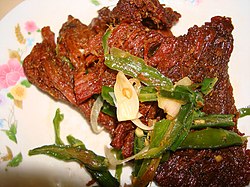 Dendeng batokok | |
| Course | Main course |
|---|---|
| Place of origin | Indonesia[1] |
| Region or state | West Sumatra |
| Serving temperature | Hot or room temperature |
| Main ingredients | Meat, spices |
Dendeng refers to thinly sliced dried meat in Indonesian cuisine.[1] It is preserved through a mixture of sugar and spices and dried via a frying process.[2] It is similar to jerky. Dendeng is traditionally produced by using some spices and sugar at various levels. Therefore, its flavour is sweet and spicy. It is also stable for several weeks at room temperature.[1]
The creation of dendeng is commonly credited to the Minangkabau people, in which their earliest dendeng was made from dried beef, so that it would be preserved for days and could be taken along with them when they traveled. The Padang cuisine version—probably the most popular dendeng dish in Indonesia—is called dendeng balado or dendeng batokok. It is a specialty from Padang, West Sumatra and is made from thinly cut beef which is dried and fried before adding chillies and other ingredients.[3]
Variations
[edit]The most common version of dendeng found in Indonesia is dendeng sapi (beef dendeng), and it usually has a sweetness from the inclusion of caramelized coconut sugar. However, versions made from other exotic meats are also available, especially in Eastern Indonesia. Dendeng rusa (deer dendeng) can be found in the Nusa Tenggara islands and Papua.[4] Indonesian Chinese favor the similar dried pork dish known as bakkwa.
Cocos Malays have been observed preserving many types of fish like jacks and barracudas this way,[5] a similar method is found among the Filipinos called daing.
See also
[edit]References
[edit]- ^ a b c Suryati, T.; Astawan, M.; Lioe, H. N.; Wresdiyati, T.; Usmiati, S. (2014-03-01). "Nitrite residue and malonaldehyde reduction in dendeng — Indonesian dried meat — influenced by spices, curing methods and precooking preparation". Meat Science. 96 (3): 1403–1408. doi:10.1016/j.meatsci.2013.11.023. ISSN 0309-1740.
- ^ Suryati, T.; Astawan, M.; Lioe, H. N.; Wresdiyati, T. (2012). "Curing Ingredients, Characteristics, Total Phenolic, and Antioxidant Activity of Commercial Indonesian Dried Meat Product (Dendeng)". Media Peternakan Institut Pertanian Bogor. 35 (2): 111. doi:10.5398/medpet.2012.35.2.111. ISSN 2087-4634.
- ^ "Dendeng Balado, Traditional Beef Dish From Padang". Taste Atlas. Retrieved 2024-01-23.
- ^ "Nikmatnya Dendeng Rusa Khas Merauke". Indonesia Kaya (in Indonesian). Retrieved 2024-01-23.
- ^ Gibson-Hill, C. A. (1946). "Boats and Fishing on the Cocos-Keeling Islands". The Journal of the Royal Anthropological Institute of Great Britain and Ireland. 76 (1): 21. doi:10.2307/2844306. ISSN 0307-3114.